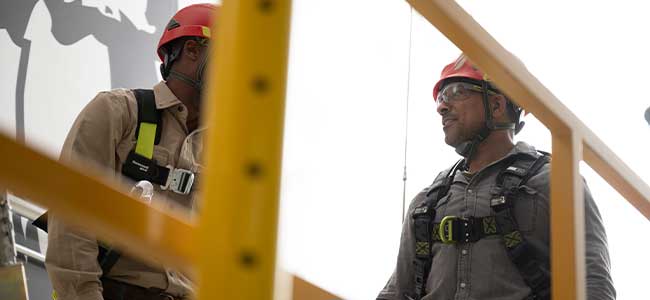
Head Injuries in Oil and Gas Industries: A Growing Impact
The prevalence and impact of head injuries in the oil and gas industry requires robust safety protocols and innovations in PPE to adequately safeguard vulnerable workers from severe risks.
- By Susan Silver
- Aug 01, 2024
Oil and gas industries are among the most hazardous sectors in the US, with a high rate of fatal and nonfatal injuries. According to the Bureau of Labor Statistics, the oil and gas extraction industry had a fatality rate of 14.1 per 100,000 workers in 2019, more than five times higher than the average for all industries.
One of the most common and serious types of injuries in this sector is head injuries, which can result from falls, struck-by objects, explosions, fires, or exposure to toxic substances. Head injuries can have devastating consequences for workers and their families, affecting their physical, cognitive, emotional, and social functioning. In this article, we will explore the causes, effects, and trends of head injuries in oil and gas industries and provide some recommendations for prevention and safety.
Causes and Effects of Head Injuries in Oil & Gas
Head injuries can occur in various ways in oil and gas industries, depending on the nature of the work, the environment, and the equipment. Some of the common causes of head injuries are:
• Falls from heights, such as ladders, scaffolds, platforms, or roofs.
• Struck-by objects, such as pipes, tools, equipment, or vehicles.
• Explosions or fires, which can cause blunt force trauma, burns, or shrapnel wounds.
• Exposure to toxic substances, such as hydrogen sulfide, which can cause respiratory distress, loss of consciousness, or brain damage.
Head injuries can range from mild to severe, depending on the location, extent, and duration of the impact or exposure. Some of the common effects of head injuries are:
• Concussion, which is a mild traumatic brain injury that can cause headaches, dizziness, nausea, confusion, memory loss, or mood changes.
• Skull fracture, which is a break in the bone that surrounds the brain, and can cause bleeding, swelling, or infection.
• Brain contusion, which is a bruise on the brain tissue, and can cause seizures, coma, or permanent damage.
• Brain hemorrhage, which is bleeding in or around the brain, and can cause increased pressure, stroke, or death.
• Diffuse axonal injury, which is damage to the nerve fibers that connect different parts of the brain, and can cause cognitive impairment, motor dysfunction, or coma.
Trends and Statistics of Head Injuries
Head injuries are a significant and growing problem in oil and gas industries, especially in the recent years of increased production and activity. According to the U.S. Bureau of Labor Statistics (BLS), which publishes annual data on occupational injuries and illnesses by industry and type of event, in 2019, there were 14 fatal injuries and 1,140 nonfatal injuries involving head injuries in the oil and gas extraction industry.
This means that head injuries accounted for 8.6 percent of all fatal injuries and 4.2 percent of all nonfatal injuries in this industry in 2019. The most common causes of fatal head injuries were struck-by objects (44 percent), falls (28 percent), and explosions or fires (17 percent), while the most common causes of nonfatal head injuries were struck-by objects (51 percent), falls (24 percent), and exposure to harmful substances (10 percent).
Recent studies also highlight the high incidence of severe injuries among contract workers in the oil and gas industry. Between January 2015 and July 2022, over 2,100 severe work-related injuries were reported, with more than 93 percent involving contractors. Common injuries in this sector include amputations, fractures, traumatic brain injuries, and burns. These injuries primarily affected those in well drilling and support activities, who often face high-hazard jobs with inconsistent training and minimal safety nets.
Head injuries were more likely to occur among workers who were:
• Younger than 35 years old.
• Employed by contractors or subcontractors.
• Working in drilling or well servicing operations.
• Working in Texas, Oklahoma, or North Dakota.
Recommendations for Prevention and Safety
To address these issues, experts recommend that oil and gas operators integrate contract workers into comprehensive safety management plans and enhance training on job hazards and equipment use. Despite some improvements in safety practices, the industry’s injury and fatality rates remain high compared to other sectors, underscoring the need for ongoing vigilance and improved safety protocols.
Head injuries in oil and gas industries are preventable if proper measures are taken to reduce the risks and hazards. Some of the recommendations include:
• Wear appropriate personal protective equipment (PPE), such as helmets, goggles, gloves, and respirators.
• Consider side impact injuries (as well as struck from above) when choosing hard hats.
• Choose technologically advanced side impact controls and chin straps available on some newer Type II climbing style helmets.
• Wear helmets securely to help increase the level of protection in the event of a fall.
• Ensure straps are worn correctly and not loose on the wearer’s chin.
• Follow the safety rules and regulations, such as lockout/tagout, confined space entry, and emergency response.
• Inspect and maintain the equipment and tools and report any defects or malfunctions.
• Use caution and awareness when working at heights, near moving objects, or in flammable or toxic environments.
• Seek medical attention and report any head injuries, no matter how minor they may seem.
• Participate in training and education programs on head injury prevention and management
This article originally appeared in the July/August 2024 issue of Occupational Health & Safety.